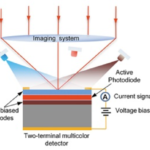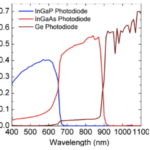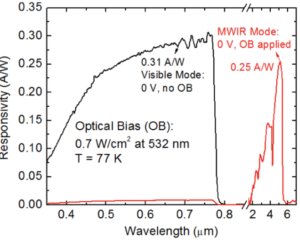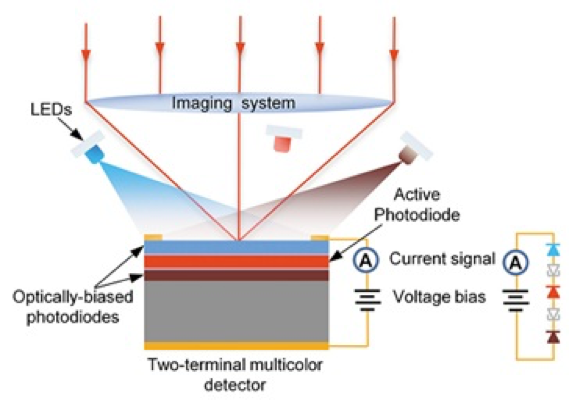E. H. Steenbergen, et al. Appl. Phys. Lett. 97 161111-161114 (2010).
A two-terminal multicolor photodetector that is most advantageous for greater than two bands is proposed. Individual color detection is realized with appropriate optical biasing. This concept is demonstrated experimentally using a three-color photodetector and biasing light emitting diodes. The measured linear dynamic range is greater than four orders of magnitude.


(a). Figure showing 2 color detector device. (b). The spectral responsivity curve of each photodiode. The responsivity was measured with matching photon flux on the inactive photodiodes.
E. H. Steenbergen, et al., Infrared Physics and Technology 54, 292-295 (2011).
Multicolor photodetectors often require more than two terminals, making it very difficult to construct multicolor FPAs, due to the increased processing complexity. This novel device concept is demonstrated using LEDs as the optical bias sources and a three-color detector. Varying light bias levels expose the effects of, luminescence coupling, optical leakage, and shunt leakage currents on the detector performance.
O.O. Cellek, et al., Applied Physics Letters 100, 241103-241103. (2012)
Optically addressed dual-band photodetector incorporating of a 0.82 µm cut-off wavelength near-infrared (NIR) AlGaAs/GaAs p-i-n photodetector and a 8.2 µm peak wavelength long-wave infrared (LWIR) AlGaAs/GaAs quantum well infrared photodetector on GaAs substrate is fabricated and characterized. Switching between NIR and LWIR bands is demonstrated by using external light bias. The dual-band photodetector gives 65% quantum efficiency in NIR band and specific detectivity of 2 x 109 cm Hz1/2/W in LWIR band at 68 K.




